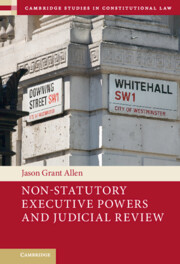Book contents
- Non-Statutory Executive Powers and Judicial Review
- Cambridge Studies in Constitutional Law
- Non-Statutory Executive Powers and Judicial Review
- Copyright page
- Dedication
- Contents
- Acknowledgements
- Table of Cases
- 1 Introduction
- 2 Official Action beyond Statute
- 3 The ‘Third Source’ in the Courts
- 4 A Unified Category of ‘Non-Statutory Executive Powers’
- 5 The Crown as Corporation
- 6 Public Law as the Law of Public Offices
- 7 Office in Action
- 8 Approaching Judicial Review
- 9 Competence, Conduct, and Validity
- 10 Moving beyond the Ultra Vires Debate
- 11 The Common Law Theory of Ultra Vires
- 12 The Borders of the Supervisory Jurisdiction
- 13 The Normative Foundations of Judicial Review
- Index
4 - A Unified Category of ‘Non-Statutory Executive Powers’
Published online by Cambridge University Press: 18 August 2022
- Non-Statutory Executive Powers and Judicial Review
- Cambridge Studies in Constitutional Law
- Non-Statutory Executive Powers and Judicial Review
- Copyright page
- Dedication
- Contents
- Acknowledgements
- Table of Cases
- 1 Introduction
- 2 Official Action beyond Statute
- 3 The ‘Third Source’ in the Courts
- 4 A Unified Category of ‘Non-Statutory Executive Powers’
- 5 The Crown as Corporation
- 6 Public Law as the Law of Public Offices
- 7 Office in Action
- 8 Approaching Judicial Review
- 9 Competence, Conduct, and Validity
- 10 Moving beyond the Ultra Vires Debate
- 11 The Common Law Theory of Ultra Vires
- 12 The Borders of the Supervisory Jurisdiction
- 13 The Normative Foundations of Judicial Review
- Index
Summary
This chapter sets out the taxonomy of non-statutory executive powers ultimately adopted. It is a very simple taxonomy that draws a fundamental distinction between statutory and non-statutory executive powers but no distinctions for the purposes of judicial review between non-statutory executive powers associated with the Royal Prerogative and those that are more mundane, and appear to be nothing more than the ‘residual liberties’ of the Crown as a legal person. Once the logic of office, official empowerment, and official action is adopted as a premise, the idea of the ‘third source’ as generally articulated simply falls away. While the distinction may be interesting or useful in a historical sense, it is of no relevance to the ‘how’ or ‘why’ of judicial review.
Keywords
- Type
- Chapter
- Information
- Non-Statutory Executive Powers and Judicial Review , pp. 62 - 78Publisher: Cambridge University PressPrint publication year: 2022

